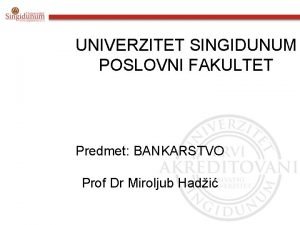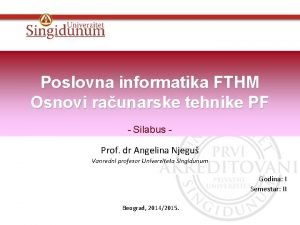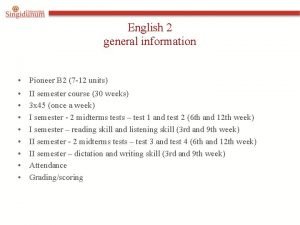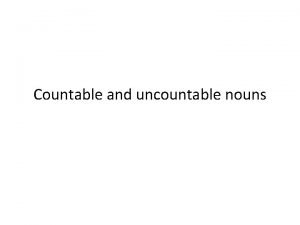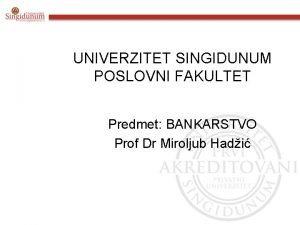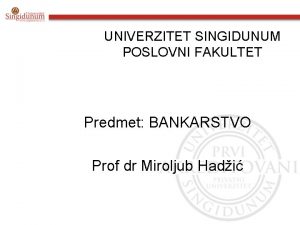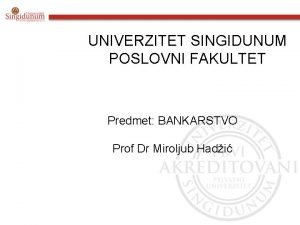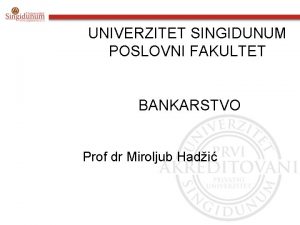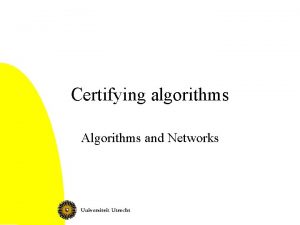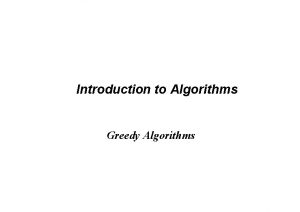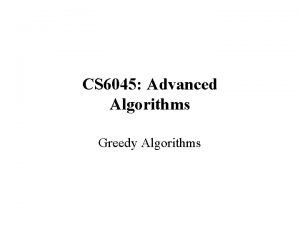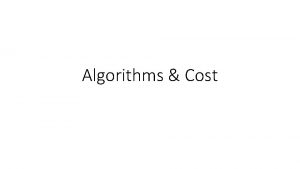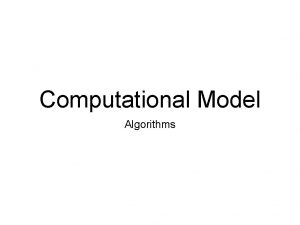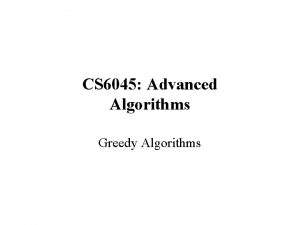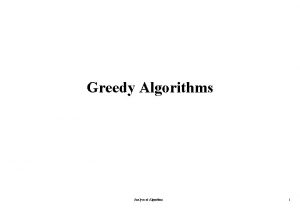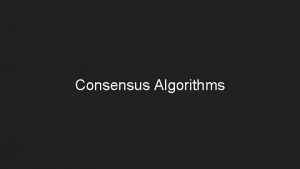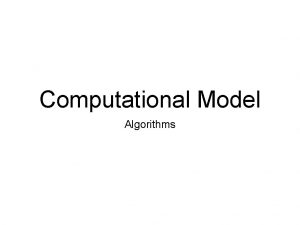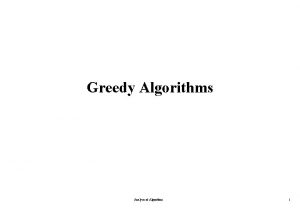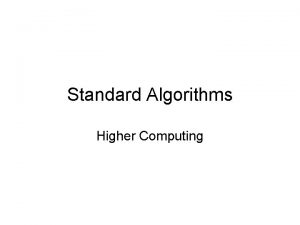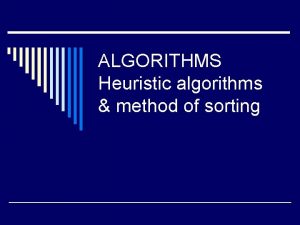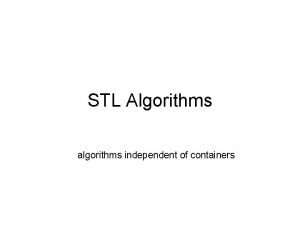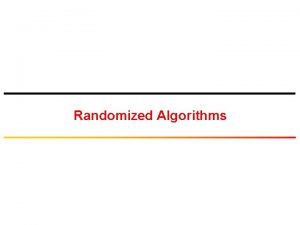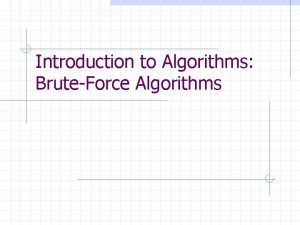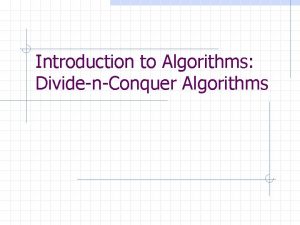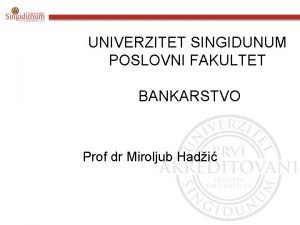www singidunum ac rs Algorithms and Datastricture Dr










![Tree Search Tree-Search(x, k) 1. if x = NIL or k = key[x] 2. Tree Search Tree-Search(x, k) 1. if x = NIL or k = key[x] 2.](https://slidetodoc.com/presentation_image/6e2bb913b351467e4419fa1e4ec3294c/image-11.jpg)
![Iterative Tree Search Iterative-Tree-Search(x, k) 1. while x NIL and k key[x] 2. do Iterative Tree Search Iterative-Tree-Search(x, k) 1. while x NIL and k key[x] 2. do](https://slidetodoc.com/presentation_image/6e2bb913b351467e4419fa1e4ec3294c/image-12.jpg)


![Pseudo-code for Successor Tree-Successor(x) • if right[x] NIL 2. then return Tree-Minimum(right[x]) 3. y Pseudo-code for Successor Tree-Successor(x) • if right[x] NIL 2. then return Tree-Minimum(right[x]) 3. y](https://slidetodoc.com/presentation_image/6e2bb913b351467e4419fa1e4ec3294c/image-15.jpg)


![Exercise: Sorting Using BSTs Sort (A) for i 1 to n do tree-insert(A[i]) inorder-tree-walk(root) Exercise: Sorting Using BSTs Sort (A) for i 1 to n do tree-insert(A[i]) inorder-tree-walk(root)](https://slidetodoc.com/presentation_image/6e2bb913b351467e4419fa1e4ec3294c/image-18.jpg)


![Deletion – Pseudocode Tree-Delete(T, z) (Contd. from previous slide) 9. if p[y] = NIL Deletion – Pseudocode Tree-Delete(T, z) (Contd. from previous slide) 9. if p[y] = NIL](https://slidetodoc.com/presentation_image/6e2bb913b351467e4419fa1e4ec3294c/image-21.jpg)










- Slides: 31

www. singidunum. ac. rs Algorithms and Datastricture Dr. Marina Marjanovic Technical Faculty and Computing University of Singidunum

Binary Trees A Binary tree is – a root – left subtree (maybe empty) – right subtree (maybe empty) B C D Properties E – max # of leaves: – max # of nodes: – average depth for N nodes: Representation: Data left right pointer F G I H J

Binary Tree Representation A A left right child B B C left right child D E F left right child left right child D C E F

Binary Trees • Recursive definition 1. An empty tree is a binary tree 2. A node with two child subtrees is a binary tree 3. Only what you get from 1 by a finite number of applications of 2 is a binary tree. 56 Is this a binary tree? 26 200 28 18 12 24 27 190 213

Binary Search Trees • View today as data structures that can support dynamic set operations. – Search, Minimum, Maximum, Predecessor, Successor, Insert, and Delete. • Can be used to build – Dictionaries. – Priority Queues. • Basic operations take time proportional to the height of the tree – O(h).

BST – Representation • Represented by a linked data structure of nodes. • root(T) points to the root of tree T. • Each node contains fields: – key – left – pointer to left child: root of left subtree. – right – pointer to right child : root of right subtree. – pointer to parent. p[root[T]] = NIL (optional).

Binary Search Tree Property • Stored keys must satisfy the binary search tree property. – y in left subtree of x, then key[y] key[x]. – y in right subtree of x, then key[y] key[x]. 12 56 26 200 28 18 24 27 190 213

Inorder Traversal The binary-search-tree property allows the keys of a binary search tree to be printed, in (monotonically increasing) order, recursively. Inorder-Tree-Walk (x) 1. if x NIL 2. then Inorder-Tree-Walk(left[p]) 3. print key[x] 4. Inorder-Tree-Walk(right[p]) 56 26 w How long does the walk take? w Can you prove its correctness? 28 18 12 200 24 27 190 213

• Correctness of Inorder-Walk Must prove that it prints all elements, in order, and that it terminates. • By induction on size of tree. Size=0: Easy. • Size >1: – Prints left subtree in order by induction. – Prints root, which comes after all elements in left subtree (still in order). – Prints right subtree in order (all elements come after root, so still in order). Comp 122, Spring 2004

Querying a Binary Search Tree • All dynamic-set search operations can be supported in O(h) time. • h = (lg n) for a balanced binary tree (and for an average tree built by adding nodes in random order. ) • h = (n) for an unbalanced tree that resembles a linear chain of n nodes in the worst case.
![Tree Search TreeSearchx k 1 if x NIL or k keyx 2 Tree Search Tree-Search(x, k) 1. if x = NIL or k = key[x] 2.](https://slidetodoc.com/presentation_image/6e2bb913b351467e4419fa1e4ec3294c/image-11.jpg)
Tree Search Tree-Search(x, k) 1. if x = NIL or k = key[x] 2. then return x 3. if k < key[x] 4. then return Tree-Search(left[x], k) 5. else return Tree-Search(right[x], k) 56 26 Running time: O(h) 28 18 Aside: tail-recursion 12 200 24 27 190 213
![Iterative Tree Search IterativeTreeSearchx k 1 while x NIL and k keyx 2 do Iterative Tree Search Iterative-Tree-Search(x, k) 1. while x NIL and k key[x] 2. do](https://slidetodoc.com/presentation_image/6e2bb913b351467e4419fa1e4ec3294c/image-12.jpg)
Iterative Tree Search Iterative-Tree-Search(x, k) 1. while x NIL and k key[x] 2. do if k < key[x] 3. then x left[x] 4. else x right[x] 5. return x 56 26 28 18 12 200 24 The iterative tree search is more efficient on most computers. The recursive tree search is more straightforward. 27 190 213

Finding Min & Max w. The binary-search-tree property guarantees that: » The minimum is located at the left-most node. » The maximum is located at the right-most node. Tree-Minimum(x) 1. while left[x] NIL 2. do x left[x] Tree-Maximum(x) 1. while right[x] NIL 2. do x right[x] 3. return x Q: How long do they take? 3. return x

Predecessor and Successor • Successor of node x is the node y such that key[y] is the smallest key greater than key[x]. • The successor of the largest key is NIL. • Search consists of two cases. – If node x has a non-empty right subtree, then x’s successor is the minimum in the right subtree of x. – If node x has an empty right subtree, then: • As long as we move to the left up the tree (move up through right children), we are visiting smaller keys. • x’s successor y is the node that x is the predecessor of (x is the maximum in y’s left subtree). • In other words, x’s successor y, is the lowest ancestor of x whose left child is also an ancestor of x.
![Pseudocode for Successor TreeSuccessorx if rightx NIL 2 then return TreeMinimumrightx 3 y Pseudo-code for Successor Tree-Successor(x) • if right[x] NIL 2. then return Tree-Minimum(right[x]) 3. y](https://slidetodoc.com/presentation_image/6e2bb913b351467e4419fa1e4ec3294c/image-15.jpg)
Pseudo-code for Successor Tree-Successor(x) • if right[x] NIL 2. then return Tree-Minimum(right[x]) 3. y p[x] 4. while y NIL and x = right[y] 5. do x y 6. y p[y] 7. return y 56 26 Code for predecessor is symmetric. 28 18 Running time: O(h) 12 200 24 27 190 213

BST Insertion – Pseudocode • Change the dynamic set represented by a BST. • Ensure the binary-search-tree property holds after change. • Insertion is easier than deletion. 56 26 28 18 12 200 24 27 190 213 Tree-Insert(T, z) 1. y NIL 2. x root[T] 3. while x NIL 4. do y x 5. if key[z] < key[x] 6. then x left[x] 7. else x right[x] 8. p[z] y 9. if y = NIL 10. then root[t] z 11. else if key[z] < key[y] 12. then left[y] z 13. else right[y] z

Analysis of Insertion • Initialization: O(1) • While loop in lines 3 -7 searches for place to insert z, maintaining parent y. This takes O(h) time. • Lines 8 -13 insert the value: O(1) TOTAL: O(h) time to insert a node. Tree-Insert(T, z) 1. y NIL 2. x root[T] 3. while x NIL 4. do y x 5. if key[z] < key[x] 6. then x left[x] 7. else x right[x] 8. p[z] y 9. if y = NIL 10. then root[t] z 11. else if key[z] < key[y] 12. then left[y] z 13. else right[y] z
![Exercise Sorting Using BSTs Sort A for i 1 to n do treeinsertAi inordertreewalkroot Exercise: Sorting Using BSTs Sort (A) for i 1 to n do tree-insert(A[i]) inorder-tree-walk(root)](https://slidetodoc.com/presentation_image/6e2bb913b351467e4419fa1e4ec3294c/image-18.jpg)
Exercise: Sorting Using BSTs Sort (A) for i 1 to n do tree-insert(A[i]) inorder-tree-walk(root) – What are the worst case and best case running times? – In practice, how would this compare to other sorting algorithms?

Tree-Delete (T, x) if x has no children case 0 then remove x if x has one child case 1 then make p[x] point to child if x has two children (subtrees) case 2 then swap x with its successor perform case 0 or case 1 to delete it TOTAL: O(h) time to delete a node

Deletion – Pseudocode Tree-Delete(T, z) /* Determine which node to splice out: either z or z’s successor. */ • if left[z] = NIL or right[z] = NIL • then y z • else y Tree-Successor[z] /* Set x to a non-NIL child of x, or to NIL if y has no children. */ 4. if left[y] NIL 5. then x left[y] 6. else x right[y] /* y is removed from the tree by manipulating pointers of p[y] and x */ 7. if x NIL 8. then p[x] p[y] /* Continued on next slide */
![Deletion Pseudocode TreeDeleteT z Contd from previous slide 9 if py NIL Deletion – Pseudocode Tree-Delete(T, z) (Contd. from previous slide) 9. if p[y] = NIL](https://slidetodoc.com/presentation_image/6e2bb913b351467e4419fa1e4ec3294c/image-21.jpg)
Deletion – Pseudocode Tree-Delete(T, z) (Contd. from previous slide) 9. if p[y] = NIL 10. then root[T] x 11. else if y left[p[i]] 12. then left[p[y]] x 13. else right[p[y]] x /* If z’s successor was spliced out, copy its data into z */ 14. if y z 15. then key[z] key[y] 16. copy y’s satellite data into z. 17. return y

Correctness of Tree-Delete • How do we know case 2 should go to case 0 or case 1 instead of back to case 2? – Because when x has 2 children, its successor is the minimum in its right subtree, and that successor has no left child (hence 0 or 1 child). • Equivalently, we could swap with predecessor instead of successor. It might be good to alternate to avoid creating lopsided tree.

Binary Search Trees • View today as data structures that can support dynamic set operations. – Search, Minimum, Maximum, Predecessor, Successor, Insert, and Delete. • Can be used to build – Dictionaries. – Priority Queues. • Basic operations take time proportional to the height of the tree – O(h).

Red-black trees: Overview • Red-black trees are a variation of binary search trees to ensure that the tree is balanced. – Height is O(lg n), where n is the number of nodes. • Operations take O(lg n) time in the worst case.

Red-black Tree • Binary search tree + 1 bit per node: the attribute color, which is either red or black. • All other attributes of BSTs are inherited: – key, left, right, and p. • All empty trees (leaves) are colored black. – We use a single sentinel, nil, for all the leaves of red-black tree T, with color[nil] = black. – The root’s parent is also nil[T ].

Red-black Tree – Example 26 41 17 30 47 38 Comp 122, Spring 2004 nil[T] 50

Red-black Properties 1. 2. 3. 4. Every node is either red or black. The root is black. Every leaf (nil) is black. If a node is red, then both its children are black. 5. For each node, all paths from the node to descendant leaves contain the same number of black nodes.

Height of a Red-black Tree • Height of a node: – Number of edges in a longest path to a leaf. • Black-height of a node x, bh(x): – bh(x) is the number of black nodes (including nil[T ]) on the path from x to leaf, not counting x. • Black-height of a red-black tree is the black-height of its root. – By Property 5, black height is well defined.

Height of a Red-black Tree h=4 26 bh=2 • Example: • Height of a node: – Number of edges in a longest path to a leaf. • Black-height of a node bh(x) is the number of black nodes on path from x to leaf, not counting x. 17 h=1 bh=1 h=2 30 bh=1 h=3 41 bh=2 h=1 bh=1 38 nil[T] h=2 47 bh=1 50 bh=1

Literature https: //www. google. com/url? sa=t&rct=j&q=&esrc=s&source=web&cd=8&ved=2 ah UKEwiyhd 6 Sq. J 7 m. Ah. VFl 4 s. KHVxm. AE 4 QFj. AHeg. QICRAC&url=https%3 A%2 F%2 F www. cs. rochester. edu%2 Fgildea%2 Fcsc 282%2 Fslides%2 FC 12 bst. pdf&usg=AOv. Vaw 3 FOVz 9052 Uet 4 Or. X_al. Z 9 M

www. singidunum. ac. rs Thank you for your attention!
 Singidunum psihologija predmeti
Singidunum psihologija predmeti Test.singidunum
Test.singidunum Singidunum literatura
Singidunum literatura Konceptualne vestine
Konceptualne vestine Singidunum fakultet za sport
Singidunum fakultet za sport Testus. singidunum.ac.rs
Testus. singidunum.ac.rs Singidunum znacenje
Singidunum znacenje Oblici nastave
Oblici nastave Dani u nedelji na italijanskom
Dani u nedelji na italijanskom Uplatnica singidunum
Uplatnica singidunum Singidunum pfb
Singidunum pfb Singidunum literatura
Singidunum literatura Stranice predmeta singidunum
Stranice predmeta singidunum Povratni glagoli italijanski
Povratni glagoli italijanski Zadatak.singidunum.ac.rs
Zadatak.singidunum.ac.rs Prevodilac
Prevodilac Stranica predmeta singidunum
Stranica predmeta singidunum Ana radulovic singidunum
Ana radulovic singidunum Predmet.singidunum
Predmet.singidunum Test. singidunum.ac.rs/student
Test. singidunum.ac.rs/student Broccoli is countable or uncountable
Broccoli is countable or uncountable Singidunum ns
Singidunum ns Ana radulovic singidunum
Ana radulovic singidunum Upravljanje projektima singidunum
Upravljanje projektima singidunum Singidunum predavanja
Singidunum predavanja Singidunum psihologija iskustva
Singidunum psihologija iskustva Singidunum anglistika cena
Singidunum anglistika cena Raspored predavanja singidunum
Raspored predavanja singidunum Singidunum psihologija
Singidunum psihologija Poslovni fakultet singidunum
Poslovni fakultet singidunum Poslovni fakultet singidunum
Poslovni fakultet singidunum Singidunum tekuci racuni
Singidunum tekuci racuni









